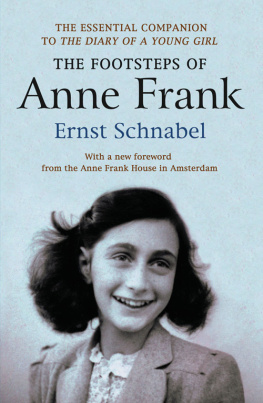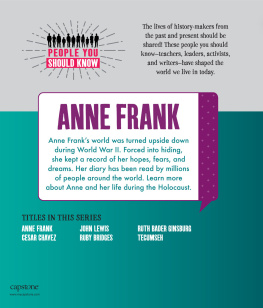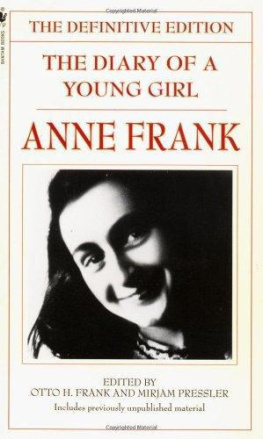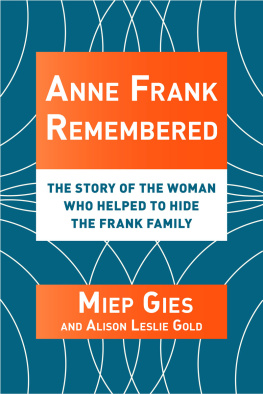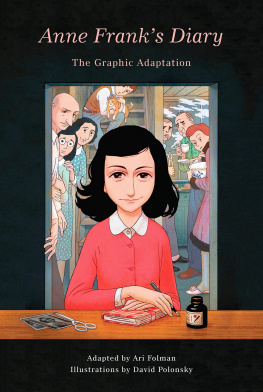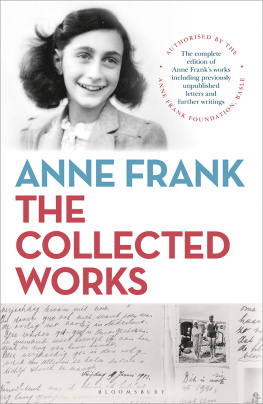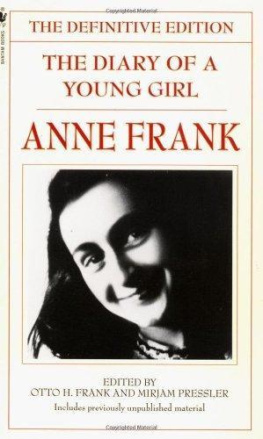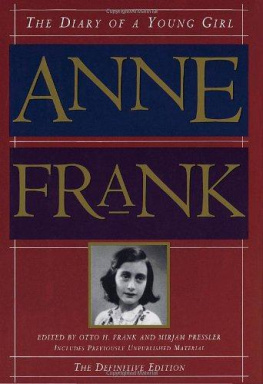
The Footsteps of Anne Frank
The name of Anne Frank is known throughout the world. The diary which this young girl wrote while for twenty-five months she and her family were hidden in the back part of an Amsterdam office building has made her a symbol of the millions of Jews who suffered and perished like her. Anne Frank died in the concentration camp at Belsen at the age of sixteen.
The story of Annes life before the Diary s start and of the tragedy that followed its abrupt ending has not hitherto been told. Ernst Schnabel has tracked down and interviewed almost every person now living who knew her. Annes father, sole survivor of the family, is the first witness; more than forty others add their testimony. And Anne herself speaks too, in some of her unpublished writings.
The later sections of this book are almost unbearably poignant. They reveal that after the familys betrayal to the Gestapo and transportation to the concentration camp of Auschwitz, Annes affectionate nature still showed itself in little acts of kindness to her companions; and even when she and her sister were taken from their parents and sent to die in the hell of Belsen her shining spirit remained indomitable to the last.
CONTENTS
by Erika Prins
by Gillian Walnes MBE
FOREWORD
Spur eines Kindes by Ernst Schnabel (known in English as The Footsteps of Anne Frank ) is a special book, a book with a history. Special because of its origins, because of the place that it occupies in the world of Anne Frank, because of its proximity in time to the events described, and not least, because of the emotional involvement of the author in the fate of Anne Frank. A book that 50 years after its first publication in German, and many reprints and numerous translations later, is now rightly available again, because it brings to life history through the words and perceptions of those who were directly involved.
Ernst Schnabel began his career as a writer in the years before World War II. During the war he served in the German navy, and afterwards found himself working for the Northwest German Broadcasting (NWDR) in Hamburg. This radio broadcaster was created by the military government in the British zone of occupation in Germany, and it had close ties with the BBC. Schnabel made a cultural programme for the NWDR, and gained experience at the BBC in London. Here he became familiar with a genre of radio documentary, the so-called radio feature: a subject is brought to life through a combination of reports, interviews, documentation and elements of the radio play, all in a dramatic setting. For Germany, this was something completely new, and in the early fifties Schnabel acquired a great reputation as a pioneer in the field. As chief dramatist and controller at the NWDR he made countless documentaries.
Das Tagebuch der Anne Frank ( The Diary of Anne Frank ), from the publisher Lambert Schneider, first appeared in Germany in November 1950, in an edition of 4,600 copies. The sales figures were disappointing and it took a long time for a second edition to appear.
The mid nineteen-fifties saw increasing worldwide interest in Anne Frank and her diary. This was the time when the stage adaptation by American writer couple Goodrich and Hackett was drawing full houses in America, and in the meantime Europe had had its own premiere of the play. Negotiations were also under way to perform the play in Germany. Around that time, in 1957, the Anne Frank House was established as an independent non-profit organisation so that the familys hiding place at 263 Prinsengracht in Amsterdam could be preserved.
Otto Frank considered the wide distribution of the diary among young Germans to be very important, but in his view that was only possible with a cheaper edition. He was right, for in March 1955 after the paperback of The Diary of Anne Frank was printed by Fischer Bcherei in an edition of 50,000 copies, 30,000 were sold within the first month. Then, with the arrival of the 375 thousandth copy of the paperback in the spring of 1957, the publisher suggested that Otto Frank provide a brief introduction to the book. The publisher had received many letters, and an increasing number of people wanted to know more about this girl, the author of the diary. Who was she, where did she come from? The Dutch and German editions differed from each other. That prompted questions. And not all the questioners appeared to be in good faith. During this period the first voices raising doubts about the authenticity of the diary were heard, and Otto Frank was determined to dispel these doubts. Eventually, in collaboration with Otto Frank, Dr. Fischer of the publishing house decided on approaching Ernst Schnabel not for an introduction, but for a whole new book in the same paperback series. In 1955 Ernst Schnabel had already considered the idea of making a radio adaptation of The Diary of Anne Frank , and he had been in contact with Otto Frank. Frank had been very interested, but before the premiere of the play in Germany a radio adaptation was out of the question.
Fischer arranged a meeting in May 1957 with Otto Frank and Ernst Schnabel in Frankfurt am Main. They were quick to agree. Ernst Schnabel would write a book for Fischer Bcherei and also make a radio adaptation based on documents, interviews with people whom Anne Frank had known, and especially with Otto Frank himself. The final version would be subject to Otto Franks approval. They had to act quickly, because the book was due for release in the spring of 1958. The German premiere of the play was scheduled for October 1, 1957. Otto Frank was fully behind the project and lost no time, as is shown by a letter written the day after the meeting in Frankfurt and sent to Aufbau , the leading German-Jewish immigrants magazine in New York:
Fischer Publishers is planning to create a book based on authentic information about Anne. I only came into contact with a few people that were together with my wife and my two daughters Margot and Anne in Birkenau-Auschwitz or Bergen-Belsen. Those that I spoke with briefly after the war, Ive lost track of again. I would now like, through an announcement or small article in Aufbau, to ask anyone who was together with my family in the camps to get in contact with me. I leave it to your judgment, how best to proceed. Of course, I will pay for the cost of an advertisement or an article.
In The Footsteps of Anne Frank and in the radio adaptation, the hand of the documentary maker is clearly recognisable. The book reads like a radio report and Schnabels notes for it convey real atmosphere. In a letter he wrote to Miep Gies in 1957 about this:
I need living people. Otherwise the result will be a dead thing. And I need also living, tangible people so that the reader can feel that Anne was living among real people and not among paper witnesses.
Ernst Schnabel followed the trace of Anne Frank and interviewed a large number of people who had consciously or unconsciously crossed her path. In the spring of 1957 Ernst Schnabel was in Amsterdam, and he literally followed her footsteps: to school, to her favourite ice cream shop, and around the neighbourhood she described in her diary. He made several visits to the hiding place, talked in particular with Otto Frank, and together with him visited friends, teachers and other acquaintances of Anne. Schnabel also spoke with Dr. Lou de Jong, director of the Institute for War Documentation created after the war in the Netherlands, and did his own research there. During his time in Amsterdam, Schnabel met several times with George Stevens, who at that time was working on shooting the Hollywood film version of the diary for Twentieth Century Fox. After Amsterdam he visited Bergen-Belsen, Frankfurt am Main and met once again with Otto Frank and his second wife in Switzerland. In early July 1957 Schnabel had finished his research and he set himself to writing. Based on the data gathered from his witnesses, on documents and his own observations he created The Footsteps of Anne Frank , a personal, passionate portrait of Anne Frank.
Next page
